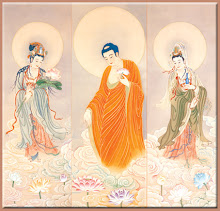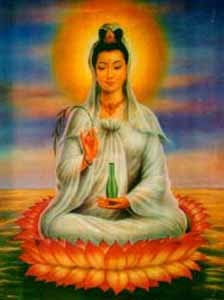
2. Great Peaceful One is White: her right hand holds a white vase which grants the action of peace Om Ah Tare Tuttare Shanting Kuru Soha.
3, The Increasing One is Yellow: her right hand holds a vase bestowing the power of increase Om Ah Tare Tuttare Shanting Kuru Soha
4. The Tara of Long Life is White her vase bestowing long lfe. Om Ah Tare Tuttare Ture Ayu Gnana Shirye Dhrum Soha
5. The Tara with the Hung is Orange: her right hand holds a vase bestowing the power of attraction,the main purpose of which is for you to bring people to the Dharma thereby bringing people to the state of enlightenment. Om Ah Tare Tuttare Ture (Your name or the person you wish to control's name) Akar Chaya Shri Soha
6. Victory over the three Worlds is dark red : her right hand holds a vase the power to intoxicate the yakshas (lesser demons) Om Ah Tare Tuttare Ture Sarwa Tutti Churu Soha
7. Destroying others black magic is Black. slightly wrathful her right hand holds a vase bestowing the power to destroy black magic. Om Ah Tare Tuttare Ture Badye Berdha Waranaya Zho Soha
8. Destroyer of the Mara is Dark Red: her right hand holds a vase bestowing the power to destroy the Maras Om Ah Tare Tuttare Ture Amagsha Trum Maraya Hung Pet Soha
9. The Three rare sublime is White: her right hand holds a vase bestowing the power to protect others from fear and dangers. Om Ah Tare Tuttare Nu Pa Sarwa Rakka Soha
10. The Destroyer the Mara is Red: her right hand holds a vase bestowing the power of destroying Maras. Om Ah Tare Tuttare Sarwa Mara Prama Tayar Hung Phet Soha
11. Eliminating from Proverty is Orange: her right hand holds a vase bestowing the power to eliminate proverty Om Ah Tare Tuttare Ture Basi Dari Soha
12. Making everything auspicious is Orange: her right hand holds a vase bestowing auspiciousness. Om Ah Tare Tuttare Ture Manglam Pushtim Kuru Soha
13. The Blazing One is Red: her right hand holds her vase to destroy your enemy., preventing him/her from creating more negativities bringing Dharma into his life and leading him to Enlightenment. Om Ah Tare Tuttare Ture Pattaya Pemi Kuru Soha
14. The Wrinkled Wrathful One is black: her right hand holds her vase bestowing the power to supress those who interfere and create obtacles. Om Ah Tare Tuttare Bendza Maha Pataya Pemi Kuru Soha
15. Great Peaceful One is White: her right hand holds a vase bestowing peace. Om Ah Tare Tuttare Ture Sarwa Papam Puta Manaye Soha.
16. Wisdom Liberating one from Hung is Red: her right hand holds a vase bestowing the power to increase the power of the mantras Om Ah Tare Tuttare Ture Sarwa Dharma Prati Shuddha Ya Soha
17. Shaking the Three Worlds is Orange: her right hand holds a vase bestowing the power to destroy the power of black mantras : Om Ah Tare Tuttare Sarwa Tam Bane Dele Soha
18. Eliminating the poison is White: her right hand holds a vase bestowing the power. Om Ah Tare Tuttare Ture Sarwa Naga Bika Shanting Kuru Soha
19. Overcoming quarrel and fight is white: her right hand holds a vase bestowing the power to eliminiate quarrels like court cases as well as nightmares. Om Ah Tare Tuttare Ture Mudza Nava Soha
20. Eliminating Epidemic is Orange: her right hand holds her vase the power to destroy all contagious diseases Om Ah Tare Tuttare Biz Aray Soha
21. For all actions to complete is white: her right hand holds a vase bestowing the power of completion Om Ah Tare Tuttare Ture Sarwa Siddhi Soha





